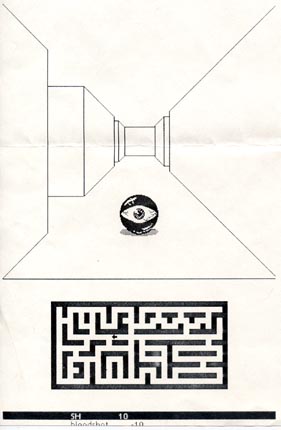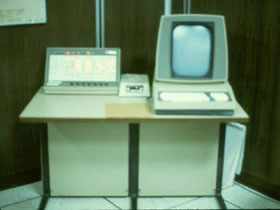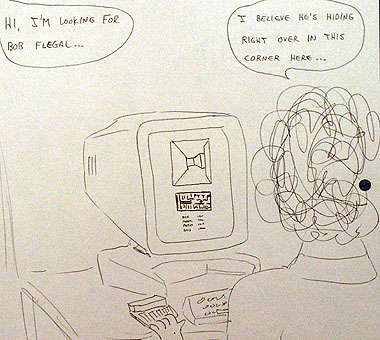DigiBarn Games: Maze War Retrospective (original) (raw)
Just Held on November 7th, 2004 Review our Maze War 30 Year Retrospective Celebrating the "World's First First Person Shooter" Click on the eyeball below for details
The Maze War 30 Year Retrospective at the DigiBarn Celebrating Thirty Years (1974) of the world's first multiplayer 3D game environment!
****Introduction to Maze War**
How we got started: a printed Screen Shot
Origins and ports of Maze War
Howard Palmer reports the True Early History of Maze War!
Maze War on Alto at Xerox PARC (notes from David Maynard)
Others Comments on Maze War
Maze War Lives Again!
Maze War 30th Birthday at the Vintage Computer Festival 7.0
More Maze War Links  DigiBarn TV Movies! Of Maze in action on various machines!
DigiBarn TV Movies! Of Maze in action on various machines!
**Introduction to Maze War
Maze War was the first networked, 3D multi-user first person shooter game. Maze War first brought us the concept of online players as eyeball "avatars" chasing each other around in a maze). From its 1974 origins on the Imlacs PDS-1 at the NASA Ames Research Center in California, to its life in project MAC at MIT, on Xerox Altos and "D* Machines" running on early ethernet, to versions ported to Mac, NeXT and PalmOS, Maze War started it all. Today's massively multiuser 3D games owe a great debt to Maze War and those who created and kept on porting it to new systems for the past 30 years. Maze War or "Maze" as it is affectionately known, is the reason why nobody can claim ownership of the rights to the invention of a multi-user 3D cyberspace.
How we got started: a printed Screen Shot

Click here to see the full scan of Dan's Xerox Star 8010 Maze War printout
See cleaned up version here Shown here (and housed in our collections) is the only known original printed screen shot of Maze War in action on the Xerox Star 8010, provided by Dan Croghan, playing the game in 1985 or 1986 at Xerox. He is seeing the game from the perspective of his desktop and his opponent is the eyeball on the screen and is named "SH". Dan is in turn the player named "bloodshot" (you can see his and his opponent's point score at the bottom). The overhead view of the maze is seen below, the 3D view above, with the player's "avatar" shown.
Dan tells us that this was a "heart pounding game" when compared to the otherwise dull environment of the Xerox document/desktop metaphor. He noted that you could "shoot" your opponent if they did not see you (their eyeball character was facing away from you). He also notes that you could "hide" in parts of the maze and wait in ambush. Presumably you could only see your location in the overhead map, not that of the other players (that would be a cheat that would make the game very boring!). You can see an almost identical image of Maze War running on a Xerox Alto here.
Origins and ports of Maze War
Played over the ethernet by researchers and regular employees alike, the earlier origins of this game at NASA Ames Research Center are reported in the section below by Howard Palmer below. David Maynard reports that at Xerox PARC, its earliest date of use was probably 1975 or 1976 on the Alto. Through research we have determined it was coded for the Xerox machines by Jim Guyton, Bruce Malasky, and assorted others at Xerox Palo Alto Research Center (PARC). We presume it was then ported to MESA for the Star, 6085/Viewpoint and later GlobalView for Sun and the PC. We don't know who did the ports for Mac, NeXT or PalmOS.
Maze War represents an early example of the division between the staid and rather uninspiring environment of document-GUI computer interfaces for "serious work" and the dynamic, social, energetic environments of virtual worlds for play.We then asked: is Maze War actually the first such environment? Know any more about "Maze"? Let us know!
Howard Palmer reports the True Early History of Maze War!
Ask and ye shall receive! Howard Palmer found our initial Maze War page and gave us some gems of history:
Cool! But I don't think it was created at Xerox originally. Here's my take on the history:
In the early 1970s, there was a group of guys at NASA Ames working under a program that Ames had with local high schools. There was a machine called an Imlac PDS-1, which was sort of like a PDP-8, but with 16 bits and a vector graphics co-processor (see https://www.blinkenlights.com/classiccmp/imlac/ ). Ames had several of these and it fell upon this group to make them do something useful. Given our ages at the time, that naturally included some games. Initially the games were 2D, similar to pong, many of which were written to exactly duplicate an arcade game in a local Togo's, for the purpose of practicing without the quarters, in order to get good enough to win a free sandwich. (No one ever won the sandwich, though, as far as I remember.)
Howard Palmer writes further:
Rather, it was a game (whose original name I can't recall) which Don O'Brien tried to exactly reproduce on the Imlac in a program he called "Drop". I think there were three rows of rectangles at the bottom of the screen, moving horizontally in different directions and different speeds. You would drop a bomb and try to hit a rectangle as it moved, with the bottom rectangles being worth the most points. No one ever won the sandwich because the game in Togo's was removed before we got good enough by practicing with Drop on the Imlacs.
 The Imlacs PDS-1 at NASA's Ames Research Center
The Imlacs PDS-1 at NASA's Ames Research Center
The senior members of this group were Steve Colley (see Steve's history of Maze here) and myself. We had written a lot of useful software for the Imlac, but never any games, and we were feeling like it was time that we proved that we, too, could write fun code. As we were sitting around brainstorming one day, we came up with idea of a networked, multiplayer maze game. I suggested to Steve that it would be really cool if it could be 3D, but Steve didn't think that the Imlac had the necessary processing power. But then I pointed out that a maze with all 90 degree angles might enable a simpler 3D rendering than the general case. Steve got excited about this, and as he often did, came back the next day with an implementation of the graphics for the maze navigation. Within a short time, networking code was added to get the multiplayer version going (we had been experimenting with ad hoc LANS for the Imlacs as part of our more serious work).
One of the members of this group, Greg Thompson, took the Ames Maze War to MIT (see Greg's description here) when he started there. Greg, Mark Horowitz (now professor Horowitz at Stanford), and George Woltman (of Mersenne Prime fame) built a hardware implementation of Maze War for a class project there. Beyond this, my knowledge is fuzzy, but I believe Maze War propagated from MIT to Xerox. Some where along the line, a version was implemented that worked over the ARPAnet, and it took off from there.
Greg Thompson can be reached at gregt@ncube.com (Steve founded nCube, sold it to Larry Ellison). He can probably give you more details about what happened with Maze War at MIT, if you're interested. He may have listings of the Imlac code.
I look forward to visiting the DigiBarn. My first computer was a Digi-Comp (see https://www.rdrop.com/~jimw/P0076.JPG), BTW.
Maze War on Alto at Xerox PARC (notes from David Maynard)
I was at Xerox P.A.R.C. when Maze Wars was first released on the Alto. I beleive this was in 1976 or 1977. It was an immediate hit with all the engineers. For a little while, work almost stopped. Management was powerless to do anything about it. You could hear the distinctive clicking of the keysets* as you walked down the hallways. One very nice feature of Maze Wars was the ability to peek around a corner without becoming visible to those in the hallway you were peeking down. This greatly added to the tension and strategy. Your description is correct in that you could only see your own location on the overhead map. It was all programmers playing, and the source code was checked into the central source code repositories, therefore it was inevitable that several unscrupulous programmers created cheat versions allowing them to become "Maze Lords" and see everyone's position. This so upset the original authors that they eventually decided to store the sources in the repository in an encrypted format. The Maze War sources were the only ones encrypted, even though these repositories contained many of the early crown jewels of computer science.
* The keyset was an input device with five piano key shaped keys that one corded with the left hand while the mose was in the right hand, re-invented by Doug Englebart at SRI when he invented the mouse. He tried to patent both devices in the late sixties. He got the patent on the mouse, along with Bill English, but discovered that the keyset was patented in the 1860's by Western Union.Others Comments on Maze War
Stan Sieler (sieler@allegro.com) writes:
I noticed the 1971 date for "Maze War" ... yet, the article doesn't seem to bear out that date. At best, towards the end, we get a mid-1970s date. The reason I'm curious about this is that I finally tracked down the programmer of SOLAR, a 3D multi-user space warfare game that ran on a Burroughs B6700... around 1972/1973. He's not familiar with other computing gaming history, and is making no claims, but I was curious :)
Ted contributed this cartoon:

Click here for a large image
Ted writes: Here is a cartoon I drew when MazeWar was new at PARC. I think the cartoon was from 1980. Harold Hall was the new head of the Systems Science Lab, SSL. He often came looking for people that he did not know. LRG is the Learning Research Group, and I and Bob Flegal were in it. I think he actually did pop in and say he was looking for Bob Flegal when one of us was playing MazeWar. I immediately drew this cartoon and posted it on the wall.
Maze War Lives Again!
For the grand opening of the DigiBarn on July 13, 2002, Don Woodward, a former Xerox guy and current collector/maintainer of Xerox hardware, got Maze War running on our Xerox 6085 network. Al Kossow let us know he actually has MESA source code for the Xerox Maze War. Don had the executables and set up GlobalView for X (Sun Solaris), GlobalView for Windows, and we then offered Maze War play to attendees on the 6085 and Windows machines. It was a thrill.
NEW! See Maze War working at the DigiBarn on Xerox 6085! (Thanks Don Woodward)
Someone reported to us that they believe that Maze War was ported to the NeXT workstation so it could well be that it continues to live on.
Maze War 30th Birthday at Vintage Computer Festival 7.0
We just celebrated the 30th anniversary (1974-2004) of Maze! See our review of the Maze War Retrospective event which was held at the VCF 7.0 on November 7th, 2004. There is a great deal more information on Maze on those pages. This event resembled our Alto 30th birthday party at the VCF in 2003.
More Maze War Links
Documentation of Maze from Imlacs on up provided by Greg Thompson
Al Kossow set up and run Maze War on Altos back in 1987, see the mention of it at his Xerox Workstations Collections page
MazeWars on the Palm Pilot:
https://www.palmgamingworld.com/action/mazewars.shtml
Further information on David Lebling who did the PDP-10 side at MIT Project Mac can be found at:
https://www.infocom-if.org/authors/lebling.html
Pictures of the Imlacs at MIT Project MAC, later called Laboratory for Computer Sciences (LCS) can be found at:
https://www.medg.lcs.mit.edu/people/psz/LCS-75/programming.html
Planet of the Feebs, a game loosely modeled on Maze War with more information here
See our Maze War brochure by Oracle for Maze being played at an InterOp conference.
Know any more about "Maze"? Contact us!